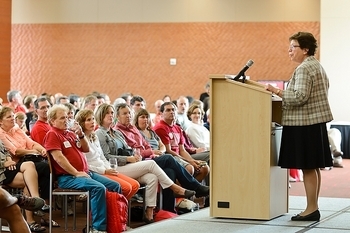You have /5 articles left.
Sign up for a free account or log in.

University of Wisconsin at Madison Chancellor Rebecca Blank talks to students' families during a parents' weekend event.
University of Wisconsin
Leaders at the University of Wisconsin at Madison have come to terms with a paradigm they find a little unpalatable: the institution needs to up its non-need-based aid if it’s going to be competitive with its peers, they say.
Madison offers one of the lowest levels of non-need-based aid, often referred to as merit aid, among fellow Big Ten universities. Institutions such as Ohio State University and the Universities of Iowa and Michigan offer more than twice as many nonneedy freshmen merit aid as Madison does.
And Chancellor Rebecca Blank says these universities, and many others, are using this aid to attract high academic achievers away from the state of Wisconsin. This is far from an unusual practice. Universities often use aid as a recruitment tool -- and as state governments have cut higher education funding, more and more public colleges are using non-need-based aid to entice out-of-staters to enroll. Institutions also use non-need-based aid as a method of attracting top-tier students in an effort to raise their academic profile.
Yet the practice is often criticized by those who would rather see universities invest in aid specifically geared toward financially needy students.
“It worries me a great deal, the type of merit aid I see being offered to top students from Wisconsin,” Blank said. “As far as I'm concerned -- I'm an economist -- that's a real waste of where we should be spending our money in higher ed. But I've got to keep some of those top students in Wisconsin.”
Blank said Wisconsin can’t afford to be one of the only universities not deeply engaged in the merit aid game, as she called it.
“We've got to play in that game. We just have to,” she said. “It is one of these arms-race things that I'm not happy with but I don't quite know what to do about.”
Stephen Burd is a policy analyst with New America who has studied student aid extensively. He and other critics of non-need-based aid say the pressures experienced at Madison are being felt throughout higher education, causing more and more universities to increase their merit aid spending and furthering a seemingly endless cycle of public universities competing with one another for students using merit aid.
“Given the level of competition that's out there, it's getting more and more difficult for institutions to resist. It’s just an incredibly competitive field now,” he said. “It’s kind of understandable that they would move in this direction, given the competition -- it’s just unfortunate.”
Madison, for example, plans to increase its merit aid levels not just for resident students, but for nonresident students as well. Thus, the university is engaging in the very practice its president decries as making recruitment efforts more difficult in her state.
“If you look at it as a country, the public system is at war with itself, and that's a shame because that means money is being wasted in a zero-sum arms race,” said Richard Kneedler, president emeritus of Franklin & Marshall College, who now works as a consultant to universities.
At Madison, Blank said, increased aid from out-of-state institutions -- coupled with a stagnant or declining number of high school graduates -- is making it more difficult to enroll resident students, particularly the highest-performing ones. She’s not happy, for example, with the number of National Merit Scholars the university enrolls -- too many of them are getting better offers from other universities. Madison enrolled 16 merit scholars in its 2014 entering class, compared to 35 at the University of Virginia (which enrolls about 1,000 fewer freshmen than Madison), 60 at the University of Michigan and 140 at the University of Minnesota.
“We're going to have to work harder to attract top Wisconsin students and keep them in the state,” she said. “The students who are going to go to Harvard, I may not be able to keep them at Wisconsin if that's the sort of experience that they want. But I have a lot of top students who get recruited away [by] Iowa and Indiana and Illinois and Minnesota. And I'll say this, we're a better school than them. They should be coming to us and not going out of state.”
Of late, the number of resident students enrolled in Madison is a highly scrutinized figure. The chancellor has promised the Legislature that Madison will enroll at least 3,600 resident freshmen each year -- a promise made in exchange for lifting a state-mandated cap on out-of-state students. This year roughly 3,600 of Madison’s 6,300 freshmen hail from Wisconsin.
Like other public universities nationally, Madison plans to tap into the nonresident market more as a way to make up for declining state funds and increase the university’s academic profile. Even with a modest aid offer, Madison nets much more revenue from nonresident students than resident ones. Madison’s resident tuition is $10,400 and its nonresident tuition is $29,700 (the average U.S. public four-year university charges $9,400 for residents and $23,900 for nonresidents).
Last year about 7 percent of Madison’s undergraduates had no need and received non-need-based aid. The average grant was $3,880. This average is less than the average awards at Madison’s Big Ten peers, and officials at the university want to bring the level up so Madison’s on more competitive ground -- although they say they are still working to figure out a sweet spot in terms of how much merit aid to offer.
| Public Flagship |
Percent of students who received non-need-based aid & had no financial need |
Average Grant |
|
University of Wisconsin |
7% | $3,880 |
|
University of Minnesota |
7% | $5,000 |
|
University of Illinois |
12% | $4,740 |
|
University of Iowa |
16% | $4,740 |
|
University of Michigan |
16.4% | $7,540 |
|
Ohio State University |
17.5% | $6,420 |
|
Indiana University |
27% | $8,430 |
|
Source: 2014-15 Common Data Set. Some institutions reported 2014 figures and others reported 2015 figures. |
||
Noel Tomas Radomski, director for the Wisconsin Center for the Advancement of Postsecondary Education and a critic of non-need-based aid, said the average grant would need to be upped significantly if Madison expects to see significant changes in behavior from applicants.
“The campus will have to offer a substantial amount of merit-based aid to compete with other states,” he said. “To some degree it's a zero-sum game. Unless you get a significant chunk of change.”
Excluding athletic scholarships, Madison gave all resident students -- those with financial need and those without -- $16.2 million in non-need-based aid, compared to $22.6 million in need-based aid. It gave nonresidents $11.3 million in non-need-based aid, and $9.2 million in need-based aid. Historically the vast majority of non-need-based aid at Madison has been administered through the university’s individual colleges, although the university is beginning to centralize its scholarship offerings. For example, students can now apply for most scholarships through a single application.
The university is in the midst of a $3.2 billion fund-raising campaign, and a priority of the drive is student aid. The primary focus, according to Steve Hahn, Madison’s vice provost for enrollment management, is to raise enough non-need-based aid to “build a wall around our state and make sure that our own students have every reason to consider us.” But fund-raising won’t be limited to aid for Wisconsin students.
“We also look for the out-of-state, of course,” said Hahn. “Our out-of-state pool is extremely competitive at the moment.”
Hahn said out-of-state students generally receive a higher ratio of merit aid than need-based aid because they don’t qualify for many of the need-based aid programs the university and the state run. He also said that with many out-of-state students, for whom tuition is much higher than resident students, “the difference between need and merit is rather slight,” especially for those on the lower end of the family income spectrum.
“Historically we have recognized that the vast majority of our money, scholarships and everything should go to the neediest students. We’ve been used to the philosophy of need-based aid as a primary objective. Of course that's not going away,” said Hahn, who added that the university is also looking to increase its need-based aid through fund-raising, but has more ground, relative to its peers, to make up with its merit aid offerings. He concedes that a new reality is complicating the university’s egalitarian history.
“The times we live in, as the chancellor said, demand that we do more in terms of merit money,” he continued. “‘Arms race’ is a little bit of a strong characterization. We are participating in the recruitment and the financial aid world that we live in.”
Kevin Crockett, president of the enrollment management division at higher education consulting firm Ruffalo Noel Levitz, which does not work with Madison, said non-need-based aid, in many cases, is a positive thing. Much of it, he said, ends up meeting financial need.
For example, Madison reported that it gave out $27.5 million in non-need-based aid last year. Yet, when it reported its merit aid to the federal government and extrapolated the merit aid that was also used to meet financial need, that figure was cut by two-thirds: around $9 million in aid was awarded to students who had no financial need.
Crockett and others who defend non-need-based aid also said it’s a reflection of a competitive marketplace.
“Sticker prices have outpaced family income,” he said. For example, according to a recent College Board report, resident tuition and fees at Midwestern public universities have grown 24 percent faster than inflation in the last decade. Merit aid is a form of price correction, Crockett said: “It’s trying to better align what families are able to pay with what schools are charging.”
Yet other analysts point out that non-need-based aid allows institutions to offer such price corrections on the basis of academic performance or residency, and not perhaps on factors that would make a price correction most equitable, such as financial need.
“You don't want to be giving scarce dollars to students who would have been going to college otherwise,” said Justin Draeger, president of the National Association of Student Financial Aid Administrators.
Radomski is not convinced that merit aid alone is why Madison is losing students to other universities. He says Madison should focus on other initiatives, aside from non-need-based aid, to increase its yield of academically competitive in-state students, such as upping recruiting efforts and going after more transfer students. Wisconsin has a robust two-year college program that feeds thousands of students into four-year universities each year. More than 1,000 transfer students were admitted to the university last year.
Craig Goebel, a partner with the higher education consulting firm Art & Science, which does not work with Madison, also said that merit aid “is not the silver bullet” that alone will solve Madison’s recruitment problem. The university also has to be seen as having a high value proposition, he said, and “focus on the substantive part of the educational experience.” Merit aid, he said, is a short-term fix.
Hahn said increasing non-need-based aid, while a focus, isn’t the only thing Madison is doing to try to attract more Wisconsin students to the university. It has also begun engaging them earlier in their high school careers -- a slight change Hahn expects to yield big results.
Yet merit aid is clearly crucial to Madison’s recruitment strategy -- the very reason being because it is central to most all their competitors’ strategies. Draeger called Wisconsin's foray deeper into merit aid part of a “terrible spiral,” the root cause of which is lackluster or declining state funding. In Wisconsin, for example, the governor and Legislature recently cut the higher education budget by $250 million over two years.
Given that Wisconsin is far from alone in public universities that have faced or are facing cuts, Draeger and others say there’s no end in sight to what many, including Madison’s own chancellor, are dubbing an increasingly threatening merit-aid arms race.
“Public universities have an increased pressure to start acting like private schools,” Draeger said. “You need all of the four-year schools to band together and not play the game, and I just don't know how you would get to that.”








